
In firearm designs, the term single-shot refers to guns that can hold only a single round of ammunition inside and thus must be reloaded manually after every shot. Compared to multi-shot repeating firearms ("repeaters"), single-shot designs have no moving parts other than the trigger, hammer/firing pin or frizzen, and therefore do not need a sizable receiver behind the barrel to accommodate a moving action, making them far less complex and more robust than revolvers or magazine/belt-fed firearms, but also with much slower rates of fire.

In firearms terminology, an action is the functional mechanism of a breech-loading firearm that handles the ammunition cartridges, or the method by which that mechanism works. Actions are technically not present on muzzleloaders, as all those are single-shot firearms with a closed off breech with the powder and projectile manually loaded from the muzzle. Instead, the muzzleloader ignition mechanism is referred to as the lock.
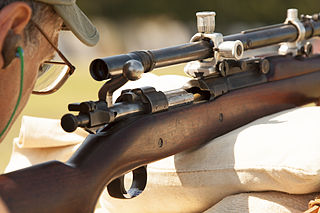
The chamber of a firearm is the cavity at the back end of a breechloading weapon's barrel or cylinder, where the ammunition is inserted before being fired. The rear opening of the chamber is the breech, and is sealed by the breechblock or the bolt.
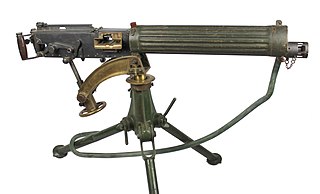
The Vickers machine gun or Vickers gun is a water-cooled .303 British (7.7 mm) machine gun produced by Vickers Limited, originally for the British Army. The gun was operated by a three-man crew but typically required more men to move and operate it: one fired, one fed the ammunition, the others helped to carry the weapon, its ammunition, and spare parts. It was in service from before the First World War until the 1960s, with air-cooled versions of it on many Allied World War I fighter aircraft.
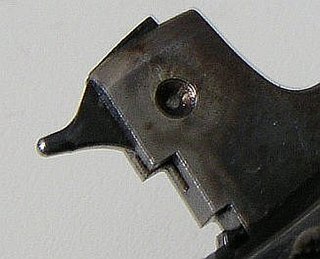
A firing pin or striker is a part of the firing mechanism of a firearm that impacts the primer in the base of a cartridge and causes it to fire. In firearms terminology, a striker is a particular type of firing pin where a compressed spring acts directly on the firing pin to provide the impact force rather than it being struck by a hammer.
The Krag–Petersson was the first repeating rifle adopted by the armed forces of Norway and was one of the first repeating rifles to be adopted as standard issue by a military force, being preceded by the Swiss Vetterli adopted in 1867. Developed by Ole Herman Johannes Krag, the action of the Krag–Petersson was uniquely actuated by an oversized hammer. Another distinguishing feature was that the cartridge rising from the magazine was not seated automatically, but had to be pushed into the breech of the rifle.

The M1901 Mannlicher Self-Loading, Semi-Automatic Pistol was an early semi-automatic pistol design. The Bundeswehr Museum of German Defense Technology in Koblenz has one of these specimen in its collection.

A breechblock is the part of the firearm action that closes the breech of a breech loading weapon before or at the moment of firing. It seals the breech and contains the pressure generated by the ignited propellant. Retracting the breechblock allows the chamber to be loaded with a cartridge.
The Spencer repeating rifles and carbines were 19th-century American lever-action firearms invented by Christopher Spencer. The Spencer was the world's first military metallic-cartridge repeating rifle, and over 200,000 examples were manufactured in the United States by the Spencer Repeating Rifle Co. and Burnside Rifle Co. between 1860 and 1869. The Spencer repeating rifle was adopted by the Union Army, especially by the cavalry, during the American Civil War but did not replace the standard issue muzzle-loading rifled muskets in use at the time. Among the early users was George Armstrong Custer. The Spencer carbine was a shorter and lighter version designed for the cavalry.
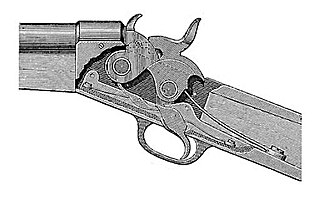
A rolling-block action is a form of firearm action where the sealing of the breech is done with a specially shaped breechblock able to rotate on a pin. The breechblock is shaped like a section of a circle. The breechblock is locked into place by the hammer, thus preventing the cartridge from moving backwards at the moment of firing. By cocking the hammer, the breechblock can be rotated freely to reload the weapon.

An interrupted screw or interrupted thread is a mechanical device typically used in the breech of artillery guns. It is believed to have been invented in 1845.

A bolt is the part of a repeating, breechloading firearm that blocks the rear opening (breech) of the barrel chamber while the propellant burns, and moves back and forward to facilitate loading/unloading of cartridges from the magazine. The firing pin and extractor are often integral parts of the bolt. The terms "breechblock" and "bolt" are often used interchangeably or without a clear distinction, though usually, a bolt is a type of breechblock that has a nominally circular cross-section.

Locked breech is the design of a breech-reloading firearm's action. This is important in understanding how a self-reloading firearm works. In the simplest terms, the locked breech is one way to slow down the opening of the breech of a self-reloading firearm when fired. The source of power for the movement is recoil.
A falling-block action is a single-shot firearm action in which a solid metal breechblock slides vertically in grooves cut into the breech of the weapon and is actuated by a lever.
The 7.5×54mm French, 7.5 French, or 7.5 MAS is a rimless bottlenecked rifle cartridge. It was developed by France as an update to the 7.5×57mm MAS mod. 1924 cartridge. It replaced the obsolete 8×50mmR Lebel round used during World War I, and served as the French service cartridge until superseded by the 5.56×45mm NATO and 7.62×51mm NATO cartridges in the 1970s and 1980s.
The 37 mm Automatic Gun, M4, known as the T9 during development, was a 37 mm (1.46 in) recoil-operated autocannon designed by Browning Arms Company. The weapon, which was built by Colt, entered service in 1942. It was primarily mounted in the Bell P-39 Airacobra and P-63 Kingcobra, with the U.S. Navy also utilizing it on many PT boats.

The Ruger Hawkeye is a single-shot pistol chambered for the .256 Winchester Magnum cartridge, produced by Sturm, Ruger & Co. from 1963 until July 1964. It was built on the same frame as the Ruger Blackhawk, but rather than having a rotating cylinder like a standard revolver, it featured a swiveling breechblock which allowed an individual round to be loaded and sealed into the frame.
The MK 115 was an autocannon developed in Germany in late World War II by Rheinmetall-Borsig for use in aircraft. It was an unusual development in that although it employed a locked breech, it also used a funnel to allow some of the propellant gases to escape out the rear in order to reduce recoil when firing, essentially being an automatic recoilless rifle. The MK 115 was chambered for a 5.5 cm round, but used a partially combustible cartridge, leaving only the base of the cartridge to eject. The MK 115 was a gas-operated, belt-fed weapon, and its breechblock used a swinging lock mechanism. It had a rifled barrel with an 8°30′ twist. A single prototype in the late stages of development was captured by the Western allies.

The Colt-Burgess rifle, also known as the 1883 Burgess rifle or simply the Burgess rifle, is a lever-action repeating rifle produced by Colt's Patent Firearms Manufacturing Company between 1883 and 1885. The Burgess rifle was Colt's only entrance into the lever-action rifle market, produced to compete with Winchester Repeating Arms Company's line of popular rifles. The 1883 Burgess rifle was designed and patented by Andrew Burgess, an American firearms designer and photographer, who sold the design to Colt.
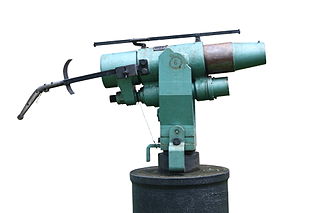
A harpoon cannon is a whaling implement developed in the late 19th century and most used in the 20th century. It would be mounted on the bow of a whale catcher, where it could be easily aimed with a wide field of view at the target. Powered by black powder and later, smokeless powder, it would generally fire a large steel harpoon, either solid steel or fitted with an exploding black powder, or later, penthrite (PETN) grenade.













